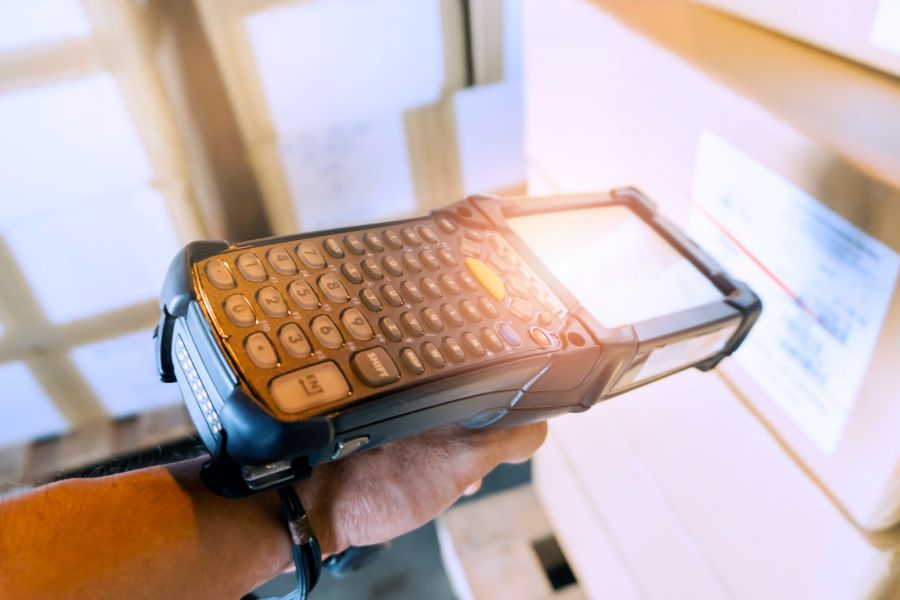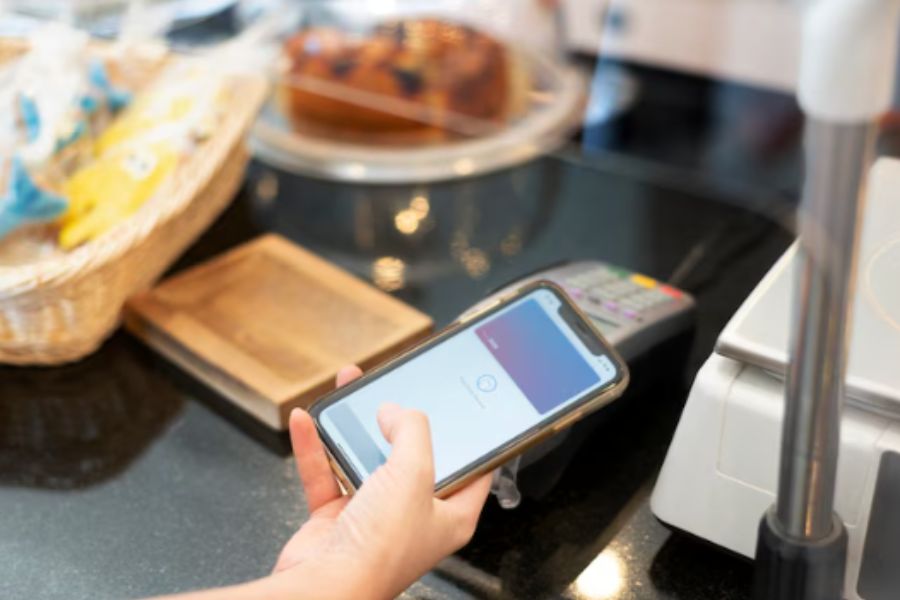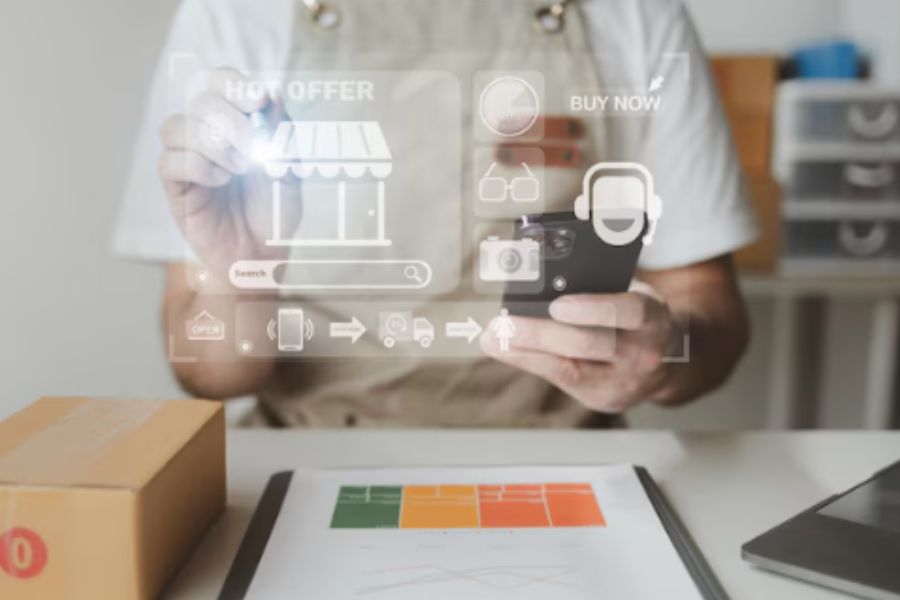Dive into the world of mobile POS systems for Retailers with our comprehensive guide. Mobile POS systems seamlessly combine the convenience and flexibility of mobile technology with the comprehensive functionality of traditional point-of-sale systems. It allows retailers to conduct transactions anywhere, enhancing customer interactions and operational efficiency. This guide offers an in-depth look at how the mobile POS system can transform retail operations, streamline sales processes, and significantly improve service delivery, equipping you with the knowledge to take your business to the next level.
What is a mobile POS system?
A mobile POS system (or mPOS) is a versatile hardware and software solution designed for processing sales on the go. While it performs all the functions of a traditional POS system, it has the added advantage of not being confined to a single checkout counter.
With an mPOS, you can install POS software onto a tablet or smartphone, allowing you to serve customers from anywhere within your store or even at off-site locations. This flexibility means your shop no longer requires a dedicated checkout counter, as your checkout process can move to wherever it is needed, enhancing the shopping experience for your customers and streamlining your sales operations.
How Does a Mobile POS System Work?
Step 1: Customer selects products
The journey begins when the customer engages with the merchandise, browsing through a selection of products either displayed in-store or at an off-site location. With the convenience of a mobile POS system, they have the freedom to explore the inventory without being tethered to a specific checkout area. They can easily select items of interest, whether it’s a new gadget, trendy apparel, or everyday essentials.
Step 2: mPOS calculates the total price
As the customer makes their selections, the mobile POS system comes into play, seamlessly integrating with the browsing experience. Each item chosen is added to the virtual shopping cart using the mPOS software.
Behind the scenes, the system accurately calculates the total price, factoring in the cost of each item, any applicable taxes, and any discounts or promotions automatically applied. This dynamic pricing ensures transparency and convenience for both the customer and the merchant.
Step 3: Customer makes payment
With the shopping experience complete, the customer proceeds to the checkout process. Here, the mobile POS system offers a variety of payment options to suit the customer’s preferences.
Whether they prefer the ease of tapping their contactless card or mobile device, inserting a chip card, swiping a traditional card, or even paying with cash, the mPOS terminal accommodates their choice. This flexibility empowers customers to complete their transactions securely and efficiently, enhancing their overall shopping experience.
Step 4: Transaction is completed
Once the payment is processed successfully, the mobile POS system finalizes the transaction. The customer receives a detailed receipt, either in digital or print format, summarizing their purchases and providing proof of payment.
Simultaneously, the merchant’s inventory is updated in real-time, reflecting the items sold and adjusting stock levels accordingly. This seamless integration between the point of sale and inventory management systems ensures accuracy and efficiency in tracking sales and managing inventory.
Step 5: Enhancing the retail experience
Beyond facilitating transactions, a mobile POS system contributes to a positive shopping experience for both customers and merchants. By removing the constraints of a traditional checkout counter, mPOS empowers staff to engage with customers on the sales floor, providing personalized assistance and recommendations.
This hands-on approach fosters a sense of connection and satisfaction, ultimately driving customer loyalty and repeat business. Additionally, the POS system’s mobility enables merchants to expand their sales channels beyond brick-and-mortar locations, facilitating transactions at events, markets, or pop-up shops with ease.
In summary, a mobile POS system revolutionizes the retail experience by offering flexibility, convenience, and efficiency at every stage of the transaction process. From browsing to payment, mPOS empowers customers and merchants alike, transforming traditional retail interactions into seamless, personalized experiences.
Benefits of A Mobile POS
- Cost-effective hardware solution
By leveraging a POS app, businesses can forgo the need for expensive, custom hardware setups. This is achieved by downloading the full functionality onto standard mobile devices such as smartphones and tablets. Utilizing standardized hardware not only reduces initial investment costs but also simplifies repair or replacement processes.
Furthermore, when the POS operates as a native app for either iOS or Android platforms, it ensures high performance, security, and responsiveness. A native app designates the POS as mobile-first and intuitive, enhancing the user experience for both store associates and customers.
With standard hardware and a native app, store associates can efficiently handle troubleshooting and updates, eliminating the necessity for external field service support.
- Enhanced payment flexibility with contactless transactions
The integration of mobile contactless payments amplifies the capabilities of the mobile POS system. Contactless payments, which were already gaining traction pre-pandemic, are now considered essential by customers rather than merely a luxury.
Mastercard Contactless Consumer Polling indicates that over half of Americans utilize some form of contactless payment, including credit cards and mobile wallets like Apple Pay. Contactless payment methods not only offer convenience but also contribute to a sense of safety, particularly during transactions such as curbside pickup, where customers can complete transactions without physical contact.
- Transition to digital receipts for mobility
Digital receipts enhance the mobility of your POS system, aligning with customers’ growing expectations of contactless transactions. They are perceived as safer, cleaner, and more convenient, catering to the preferences of environmentally conscious consumers who prioritize sustainability.
In the UK alone, the staggering number of 11.2 billion paper receipts printed in 2019 underscored the urgency for eco-friendly alternatives, with the associated costs exceeding £32 million. Despite this, half of high street brands have yet to adopt sustainable receipt practices, as reported by Econsultancy.
Digital receipts not only reduce paper waste but also serve as a valuable tool for collecting customer email addresses, with proper consent, to bolster your marketing database and enhance customer engagement.
- Seamless scalability
A cloud-native mobile point-of-sale system is designed for effortless scalability, offering businesses the flexibility to adapt to changing demands and seasonal fluctuations. Adding new checkout options within a store becomes a simple and straightforward process, enhancing service quality without the need for costly installations of additional cash registers.
Moreover, scaling operations up or down can be achieved swiftly, with the ability to activate an extra POS within minutes. With all the built-in functionality and access to centralized information, activating a fully operational mobile POS system is as easy as downloading an app onto a mobile device.
Equipped with features such as contactless payments, built-in scanner/camera capabilities, and digital receipts, businesses can effectively manage operations with just a mobile device.
- Quick deployment for pop-up stores
A mobile point of sale system simplifies the setup of pop-up stores or facilitates point-of-sale presence at events or trade shows. As retail rebounds following the COVID-19 pandemic, pop-up stores are poised to play a significant role in brand engagement.
They offer a low-risk opportunity for customers to interact with the brand without the commitment of permanent premises. Leveraging a mobile POS solution streamlines the establishment of pop-up stores, enabling businesses to extend their reach and engage with customers in diverse settings.
- Efficient line-free checkout
With the increasing aversion to waiting in lines, particularly amidst social distancing measures, businesses are challenged to provide expedited checkout experiences. A mobile-first and responsive POS system offers various checkout options to address this concern.
Whether it’s utilizing mobile checkout, countertop devices, or self-checkout options, businesses can deploy a combination of strategies to minimize wait times and enhance customer satisfaction. Additionally, a mobile POS system solution enhances safety by allowing payments to be taken anywhere inside or outside the store, accommodating customers’ preferences and contributing to a seamless shopping experience.
- Built-in inventory management
The versatility of the phone or tablet used for your mobile point of sale extends beyond processing transactions—it also serves as a powerful tool for inventory management. With built-in capabilities for stocktaking, inventory receiving, and inter-store stock transfers, businesses can streamline their inventory operations directly from the POS device.
Partial cycle counts and automated warehouse transfers, triggered by predefined reason codes, enhance accuracy and minimize errors. By integrating inventory management with the POS system, businesses can conduct regular stock verifications, reducing discrepancies and maintaining accurate stock levels throughout the year.
- Simplified assisted selling
Empowering staff with the ability to complete sales transactions anywhere in the store revolutionizes the concept of assisted selling. Freed from the constraints of traditional sales counters, staff can engage with customers more effectively, reducing waiting times and eliminating the need for queuing.
The mobility afforded by mPOS solutions facilitates seamless assisted selling experiences, enabling staff to provide personalized assistance and recommendations on the spot. This approach sets businesses apart from competitors, cultivates customer loyalty, and drives long-term sales growth.
- Empowered store associates
Your store associates are the frontline ambassadors of your brand, crucial in delivering exceptional customer experiences. An industry-leading, cloud-native mobile point of sale system empowers associates by providing them with the tools they need to excel in their roles.
By eliminating the frustrations associated with outdated or malfunctioning technology, mPOS solutions enable associates to focus on delivering superior service and engaging with customers. The ability to efficiently process transactions on the spot enhances customer satisfaction and fosters loyalty, ultimately driving increased sales.
Equipping your associates with the right tools not only enhances their job satisfaction but also elevates the overall shopping experience for your customers.
Required Hardware for Mobile POS
To operate effectively, an mPOS system typically requires the following hardware components:
- Tablet or smartphone
The core of an mPOS system is a tablet or smartphone running compatible iOS or Android software. These devices are the primary interface for processing sales, managing inventory, and generating receipts. Most mobile POS software is designed to run seamlessly on any modern tablet or smartphone, providing flexibility and accessibility for businesses of all sizes.
- Mobile card reader
A mobile card reader is essential for accepting various forms of payment, including magstripe swipes, NFC (Near Field Communication) chips, and contactless and mobile wallet transactions. These compact devices connect to the tablet or smartphone via Bluetooth or a physical connector, enabling secure and convenient payment processing on the go.
- Barcode scanner
While not always necessary, a barcode scanner enhances efficiency by simplifying product scanning during checkout. Wireless barcode scanners allow staff to quickly scan items from anywhere in the store, facilitating faster transactions and accurate inventory management. Some mPOS systems also leverage the tablet or smartphone’s built-in camera for barcode scanning, offering a cost-effective alternative.
- Cash register
If your business accepts cash payments alongside electronic transactions, a cash register may be required at designated checkout counters. While the primary focus of a mobile POS system is digital payment processing, integrating a traditional cash register ensures versatility and accommodates customers who prefer cash transactions.
- Receipt printer
While mPOS systems promote paperless transactions through email receipts, providing printed receipts remains a customer preference for some businesses. A receipt printer, typically located near the cash register, enables businesses to offer both digital and paper-based receipt options, catering to diverse customer preferences.
By incorporating these hardware components into an mPOS setup, businesses can harness the full potential of mobile technology to streamline operations, enhance customer experiences, and adapt to evolving payment preferences.
Challenges of Implementing A Mobile POS System
While mobile POS systems offer numerous benefits, businesses may encounter several challenges when implementing and using them:
- Connectivity issues
Reliance on internet connectivity poses a significant challenge for mPOS systems, especially in areas with poor network coverage or during network outages. Limited or unreliable connectivity can disrupt transaction processing, inventory management, and other critical functions, leading to delays and potential loss of sales.
- Security concerns
Mobile devices used for mPOS transactions are susceptible to security threats such as data breaches, malware attacks, and unauthorized access. Ensuring the security of customer payment data and sensitive business information requires robust encryption, authentication measures, and adherence to industry security standards. Failure to implement adequate security measures can result in financial losses, reputational damage, and regulatory penalties.
- Hardware compatibility
Compatibility issues may arise when integrating mPOS software with different types of mobile devices, card readers, barcode scanners, and receipt printers. Ensuring seamless compatibility and interoperability among hardware components is essential for optimizing system performance and avoiding technical glitches.
- Training and adoption
Training employees to use mPOS systems effectively is crucial for maximizing their benefits. However, staff may face challenges in adapting to new technologies, workflows, and processes, leading to resistance or reluctance to embrace mPOS solutions. Investing in comprehensive training programs and providing ongoing support can help mitigate these challenges and foster user adoption.
- Battery life and device reliability
Mobile devices used for mobile POS system transactions rely on battery power, which may drain quickly during prolonged use. Additionally, device reliability and durability are essential factors, as frequent hardware failures or malfunctions can disrupt business operations and impact customer service. Implementing backup power solutions and regularly maintaining mobile devices can help mitigate these risks.
- Regulatory compliance
Compliance with industry regulations and payment card security standards (such as PCI DSS) is critical for businesses using mPOS systems. Failure to adhere to regulatory requirements can result in fines, legal liabilities, and loss of customer trust. Businesses must stay informed about evolving regulatory frameworks and implement measures to ensure compliance across their mPOS operations.
Addressing these challenges requires careful planning, proactive management, and ongoing investment in technology, training, and infrastructure. By overcoming these obstacles, businesses can leverage mPOS systems to streamline operations, improve efficiency, and enhance the overall customer experience.
What makes ConnectPOS the Ideal Mobile POS System for Retail?
ConnectPOS is a versatile cloud-based POS software compatible with various platforms, including desktops, laptops, smartphones, and tablets. Specifically, the ConnectPOS iPad app seamlessly integrates with Magento, a popular e-commerce platform, making it one of the top choices for iPad-based POS solutions.
Android users need not fret, as ConnectPOS also offers a Progressive Web App (PWA) that works flawlessly on mobile devices across all operating systems, accessible via web browsers.
The ConnectPOS app is known for its swift performance and stability, capable of efficiently managing large inventories and customer databases. It simplifies the setup process for business owners and operators by seamlessly syncing vital data and information from Magento to the POS system, enabling immediate sales and customer support.
Getting started with the ConnectPOS iPad app is a breeze, requiring just three simple steps:
- Sign up for a free trial on the website and follow the provided setup instructions.
- Download the ConnectPOS iPad app from the App Store.
- Log in to your account, connect the device to your POS hardware, and start using the app.
Key features of ConnectPOS include:
- Universal applicability across diverse business types.
- Expedited checkout process for enhanced efficiency.
- Real-time inventory management capabilities.
- Detailed reporting functionalities for informed decision-making.
- Offline mode support for uninterrupted operations.
- Seamless payment integration with options like PayPal Here, Authorize.Net, iZettle, Moneris, etc.
- Click-and-collect functionality for convenient customer experiences.
- Ability to ship items from a single order to multiple addresses.
- Seamless integration of online and physical store operations.
- Reward points system to incentivize customer loyalty.
FAQs: Mobile POS System
- What Types of Businesses Can Benefit from Mobile POS Systems?
Any business that requires flexibility and mobility in processing transactions can benefit, including retail stores, restaurants, cafes, food trucks, pop-up shops, event vendors, and service-based businesses like salons and repair shops.
- Are Mobile POS Systems Secure?
Yes, mPOS systems prioritize security with encryption technologies, secure payment gateways, and adherence to industry standards like PCI DSS, ensuring safe transactions and protecting customer data.
- Can Mobile POS Systems Integrate with Other Business Software?
Yes, many mPOS systems offer integration with accounting software, inventory management systems, CRM tools, and e-commerce platforms, enabling seamless data sharing and workflow automation.
- How to Choose the Right Mobile POS System for Your Business?
When choosing an mPOS system, consider factors such as your business needs, budget, scalability, hardware compatibility, ease of use, customer support, and security features. Research different providers, compare features and pricing, and test usability through demos or trials to find the best fit for your business.
Conclusion
As the retail industry continues to embrace digital transformation, mobile POS systems stand out as catalysts for innovation and growth. By empowering retailers with flexibility, mobility, and advanced functionalities, these systems have revolutionized the way transactions are conducted and customer interactions are managed.
Don’t hesitate to contact us if you’d like to learn more about ConnectPOS’s mobile POS system.



